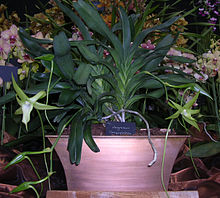| Angraecum sesquipedale | |
|---|---|

| |
| Scientific classification | |
| Kingdom: | Plantae |
| Clade: | Tracheophytes |
| Clade: | Angiosperms |
| Clade: | Monocots |
| Order: | Asparagales |
| Family: | Orchidaceae |
| Subfamily: | Epidendroideae |
| Genus: | Angraecum |
| Species: | A. sesquipedale
|
| Binomial name | |
| Angraecum sesquipedale | |
| Varieties | |
| |
| Synonyms | |
Angraecum sesquipedale /ˌsɛskwɪpɪˈdeɪliː/, also known as Darwin's orchid, Christmas orchid, Star of Bethlehem orchid, and king of the angraecums, is an epiphytic orchid in the genus Angraecum endemic to Madagascar. The orchid was first discovered by the French botanist Louis-Marie Aubert du Petit-Thouars in 1798, but was not described until 1822.[1][2] It is noteworthy for its long spur and its association with the naturalist Charles Darwin, who surmised that the flower was pollinated by a then undiscovered moth with a proboscis whose length was unprecedented at the time. Darwin's prediction went unverified for 21 years after his death, until just such a moth was discovered and his conjecture vindicated. The story of its postulated pollinator has come to be seen as one of the celebrated predictions of the theory of evolution.[2]
- ^ Petit-Thouars 1822, tab. 66
- ^ a b Arditti et al. 2012, pp. 403–432